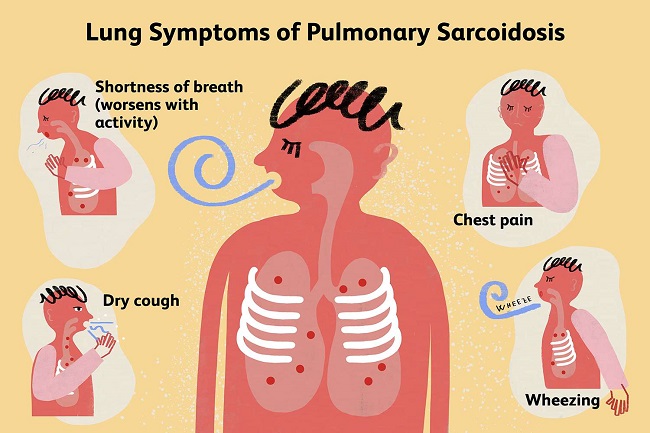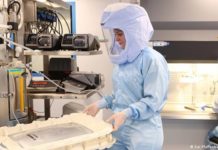Sarcoidosis is a disease that affects multiple systems of the body and can be found in many different places. Most commonly, the lungs and lymph nodes in the mediastinum and hilar regions are involved in this disease. Affected organs can include the skin, liver, and eyes.
Patients between the ages of 20 and 50 are most likely to develop this condition.
It is possible to identify Sarcoidosis based on the presence of non-caseating granulomas in various tissues or organs, such as skin.
No treatment exists to reverse the effects of Sarcoidosis, but in some cases, the disease resolves on its own. Sarcoidosis can also persist for years and damage organs if it is severe.

Sarcoidosis is an immune-mediated, multiorgan disease characterised by inflammation of cells and the development of granulomas throughout the body. We can see the immune system at work in the development of a disease such as Sarcoidosis. Lymph nodes and the lungs are the most commonly affected organs.
Sarcoidosis is referred to as pulmonary Sarcoidosis when it affects the lungs. Lung tissue becomes inflamed as a result. Pulmonary fibrosis can occur if the inflammation does not subside, resulting in stiff, inflamed lung tissue and a distorted breathing pattern.
Approximately 90% of people with Sarcoidosis are affected by lymph nodes, which is a common occurrence for this disease. As lymph nodes are found all over the body, this is a good place to start. they store and produce white blood cells
All over the body, the lymph nodes become inflamed when Sarcoidosis attacks them. There is an increase in size and the lymph nodes calcify.
Read Also:
Contents
Sarcoidosis is Caused by What?
Sarcoidosis’s aetiology is still a mystery. A few factors influence the pathogenesis of this disease, despite this:
It’s possible that the disease is brought on by factors related to one’s immediate environment. This disease may be caused by both infectious and non-infectious factors in the environment. Bacteria, viruses, and other organisms can all play a role in the development of Sarcoidosis.
Mycobacterium, Propionibacterium acnes, spirochetes, fungi, and Rickettsia are all examples of pathogens that can cause disease.
Despite the fact that Sarcoidosis can occur at any age, it is most commonly seen in patients between the ages of 20 and 50. On the other hand, females are more likely to suffer from this condition than males.
Pathogenesis of this disease can be affected by substances other than bacteria and viruses, such as chemicals. Inflammation of granulomas is caused by metals such as titanium, aluminium, beryllium, and another rare earth metal.
If a family membrane is infected with Sarcoidosis, it is more likely that other family members will be infected as well. Sarcoidosis is caused by specific HLA genotypes, such as HLA-A1 and HLA-B8.
This disease’s pathogenesis is largely due to immunological factors. Unknown antigens in the genetically suspected host are found to bind to environmental agents that are either infectious or noninfectious.
Sarcoidosis affects our bodies in a specific way as follows:
Sarcoid granulomas are the result of inflammation in the tissues or organs that underlie this condition.
Cell-mediated immune response to an unknown and unidentified antigen causes sarcoid granulomas to form.
The antigen-presenting cells take up this unknown antigen. The CD4+ helper T cells are stimulated to proliferate in response to the unknown antigen by this antigen-presenting cell, and this results in the accumulation of activated monocytes.
Interferons and interleukins are among the cytokines released by CD4+ helper T cells.
Sarcoid granulomas develop as a result of an increase in cytokines throughout the body, leading to an overproduction of helper T cells and activated monocytes in the affected area.
Sarcoidosis is Characterised by What Symptoms?
Patients may experience no symptoms at all in some cases. Inflammation of the tissue or an organ is a common symptom of this disease. Respiratory system issues such as coughing up blood and hemoptysis are common in people with Sarcoidosis.
Anorexia (an eating disorder) and an increase in ACE (Angiotensin-converting enzyme) are among the other side effects of vitamin D overdose, which causes hypercalcemia due to excess vitamin D production.
As a Disease, What is Sarcoidosis?
Sarcoidosis can’t be diagnosed properly because we don’t know what causes the disease. Still, doctors use a variety of methods to determine whether or not a patient has this disease. The following are just a few:
Diagnosing skin sarcoidosis with the Kviem test is the first step. This test involves injecting a substance derived from sarcoid tissue directly into the patient’s skin.
When the doctor examines the surface, he or she checks to see if there is any inflammation. Skin Sarcoidosis can be diagnosed if a lump of inflammation is found on the patient’s skin.
If the doctor suspects that the lymph nodes, lungs, or some other organ may be affected by cancer, an HRCT scan may be used to get a better look. This is a more precise diagnosis than the one provided by X-rays.
What are the Treatment Options for Sarcoidosis?
As the cause is still a mystery, so is the treatment for it. It’s important to note that, if left untreated, sarcoid granulomas can cause organ dysfunction due to the formation of calcium deposits in the affected tissues or organs, whereas mild cases of sarcoidosis can be treated without the need for medical intervention.
Less than 3% of patients die from pulmonary or cardiac dysfunction as a result of this disease. As many as 60% to 70% of patients with Sarcoidosis are prescribed steroids by doctors.
Read Also:
Conclusion
The patient’s awareness is the most critical factor. The patient should see their doctor on a regular basis in order to receive proper guidance and treatment.
In order for the patient to develop immunity, they must follow a well-defined and well-balanced diet. Drinking or smoking can have a negative impact on the lymph nodes and lungs if the patient isn’t careful.






![DNS_Probe_Finished_No_Internet Error [RESOLVED] Fix DNS_Probe_Finished_No_Internet Error](https://howandwow.info/wp-content/uploads/2019/09/Fix-DNS_Probe_Finished_No_Internet-Error.jpg)
![Err_Connection_Reset Error in Chrome [RESOLVED] Fix Err_Connection_Reset Error in Google Chrome](https://howandwow.info/wp-content/uploads/2019/09/Fix-Err_Connection_Reset-Error-in-Google-Chrome.jpg)
![Err_Cache_Miss in Google Chrome Error [RESOLVED] Err_Cache_Miss in Google Chrome Error](https://howandwow.info/wp-content/uploads/2019/08/How-to-Fix-Confirm-Form-Resubmission-Error.jpg)









![Steam Missing File Privileges Error [RESOLVED] How to Fix Steam Missing File Privileges](https://howandwow.info/wp-content/uploads/2020/07/How-to-Fix-Steam-Missing-File-Privileges-Error-100x70.jpg)

![SIM Not Provisioned MM#2 Error [RESOLVED] SIM Not Provisioned MM#2](https://howandwow.info/wp-content/uploads/2020/03/SIM-Not-Provisioned-MM2.jpg)







